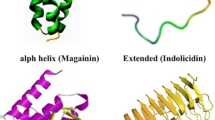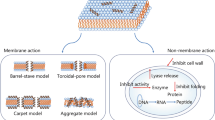Abstract
Pseudomonas aeruginosa (PA) can cause infections in compromised hosts by interacting with the glycocalyx of host epithelial cells. It binds to glycostructures on mucosal surfaces via two lectins, which are carbohydrate-binding proteins, named PA-IL and PA-IIL, and blocking this interaction is, thus, an attractive anti-adhesive strategy. The aim of this study was to determine by ciliary beat frequency (CBF) analysis whether monosaccharides or peptides mimicking glycostructures represent blockers of PA lectin binding to human airway cilia. The treatment with monosaccharides and peptides alone did not change the CBF compared to controls and the tested compounds did not influence the cell morphology or survival, with the exception of peptide pOM3. PA-IL caused a decrease of the CBF within 24 h. D-galactose as well as the peptides mimicking HNK-1, polysialic acid and fucose compensated the CBF-modulating effect of PA-IL with different affinities. PA-IIL also bound to the human airway cilia in cell culture and resulted in a decrease of the CBF within 24 h. L(−)-fucose and pHNK-1 blocked the CBF-decreasing effect of PA-IIL. The HNK-1-specific glycomimetic peptide had a high affinity for binding to both PA-IL and PA-IIL, and inhibited the ciliotoxic effect of both lectins, thus, making it a strong candidate for a therapeutic anti-adhesive drug.




Similar content being viewed by others
References
Kirkeby S, Moe D (2005) Analyses of Pseudomonas aeruginosa lectin binding to alpha-galactosylated glycans. Curr Microbiol 50(6):309–313
Gang RK, Bang RL, Sanyal SC, Mokaddas E, Lari AR (1999) Pseudomonas aeruginosa septicaemia in burns. Burns 25(7):611–616
Garau J, Gomez L (2003) Pseudomonas aeruginosa pneumonia. Curr Opin Infect Dis 16(2):135–143
Gilboa-Garber N (1982) Pseudomonas aeruginosa lectins. Methods Enzymol 83:378–385
Adam EC, Mitchell BS, Schumacher DU, Grant G, Schumacher U (1997) Pseudomonas aeruginosa II lectin stops human ciliary beating: therapeutic implications of fucose. Am J Respir Crit Care Med 155(6):2102–2104
Gilboa-Garber N, Garber N (1989) Microbial lectin cofunction with lytic activities as a model for a general basic lectin role. FEMS Microbiol Rev 5(3):211–221
Winzer K, Falconer C, Garber NC, Diggle SP, Camara M, Williams P (2000) The Pseudomonas aeruginosa lectins PA-IL and PA-IIL are controlled by quorum sensing and by RpoS. J Bacteriol 182(22):6401–6411
Zhang LH, Dong YH (2004) Quorum sensing and signal interference: diverse implications. Mol Microbiol 53(6):1563–1571
Hauber HP, Schulz M, Pforte A, Mack D, Zabel P, Schumacher U (2008) Inhalation with fucose and galactose for treatment of Pseudomonas aeruginosa in cystic fibrosis patients. Int J Med Sci 5(6):371–376
Steuer MK, Herbst H, Beuth H, Beuth J, Steuer M, Pulverer G, Matthias R (1993) Hemmung der bakteriellen Adhäsion durch Lektinblockade bei durch Pseudomonas aeruginosa induzierter Otitis externa im Vergleich zur lokalen Therapie mit Antibiotika. Otorhinolaryngol Nova 3:19–25
von Bismarck P, Schneppenheim R, Schumacher U (2001) Successful treatment of Pseudomonas aeruginosa respiratory tract infection with a sugar solution—a case report on a lectin based therapeutic principle. Klin Pädiatr 213(5):285–287
Garber N, Guempel U, Belz A, Gilboa-Garber N, Doyle RJ (1992) On the specificity of the D-galactose-binding lectin (PA-I) of Pseudomonas aeruginosa and its strong binding to hydrophobic derivatives of D-galactose and thiogalactose. Biochim Biophys Acta 1116(3):331–333
Haddadin RN, Saleh SA, Mahmoud RA, Shehabi AA (2010) Multiple drug resistance and strength of attachment to surfaces in Pseudomonas aeruginosa isolates. Lett Appl Microbiol 51(1):48–53
Høiby N, Bjarnsholt T, Givskov M, Molin S, Ciofu O (2010) Antibiotic resistance of bacterial biofilms. Int J Antimicrob Agents 35(4):322–332
Oldenburg KR, Loganathan D, Goldstein IJ, Schultz PG, Gallop MA (1992) Peptide ligands for a sugar-binding protein isolated from a random peptide library. Proc Natl Acad Sci USA 89(12):5393–5397
Scott JK, Loganathan D, Easley RB, Gong X, Goldstein IJ (1992) A family of concanavalin A-binding peptides from a hexapeptide epitope library. Proc Natl Acad Sci USA 89(12):5398–5402
Mewe M, Tielker D, Schönberg R, Schachner M, Jaeger KE, Schumacher U (2005) Pseudomonas aeruginosa lectins I and II and their interaction with human airway cilia. J Laryngol Otol 119(8):595–599
Wu L, Holbrook C, Zaborina O, Ploplys E, Rocha F, Pelham D, Chang E, Musch M, Alverdy J (2003) Pseudomonas aeruginosa expresses a lethal virulence determinant, the PA-I lectin/adhesin, in the intestinal tract of a stressed host: the role of epithelia cell contact and molecules of the Quorum Sensing Signaling System. Ann Surg 238(5):754–764
Chen CP, Song SC, Gilboa-Garber N, Chang KS, Wu AM (1998) Studies on the binding site of the galactose-specific agglutinin PA-IL from Pseudomonas aeruginosa. Glycobiology 8(1):7–16
Imberty A, Wimmerová M, Mitchell EP, Gilboa-Garber N (2004) Structures of the lectins from Pseudomonas aeruginosa: insight into the molecular basis for host glycan recognition. Microbes Infect 6(2):221–228
Johansson EMV, Kolomiets E, Rosenau F, Jaeger K-E, Darbre T, Reymond J-L (2007) Combinatorial variation of branching length and multivalency in a large (390 625 member) glycopeptide dendrimer library: ligands for fucose-specific lectins. New J Chem 31(7):1291–1299
Kolomiets E, Johansson EMV, Renaudet O, Darbre T, Reymond J-L (2007) Neoglycopeptide dendrimer libraries as a source of lectin binding ligands. Org Lett 9(8):1465–1468
Sears P, Wong CH (1999) Carbohydrate mimetics: a new strategy for tackling the problem of carbohydrate-mediated biological recognition. Angew Chem Int Ed Engl 38(16):2300–2324
Bertozzi CR, Kiessling LL (2001) Chemical glycobiology. Science 291(5512):2357–2364
Kleene R, Schachner M (2004) Glycans and neural cell interactions. Nat Rev Neurosci 5(3):195–208
Di Benedetto G, Gill J, Lopez-Vidriero MT, Clarke SW (1989) The effect of cryopreservation on ciliary beat frequency of human respiratory epithelium. Cryobiology 26(4):328–332
Wulffraat NM, Veerman AJ, Stamhuis IH (1985) Frequency and coordination of ciliary beat after cryopreservation of respiratory epithelium. Cryobiology 22(2):105–110
Tielker D, Hacker S, Loris R, Strathmann M, Wingender J, Wilhelm S, Rosenau F, Jaeger KE (2005) Pseudomonas aeruginosa lectin LecB is located in the outer membrane and is involved in biofilm formation. Microbiology 151(Pt 5):1313–1323
Garber N, Guempel U, Gilboa-Garber N, Royle RJ (1987) Specificity of the fucose-binding lectin of Pseudomonas aeruginosa. FEMS Microbiol Lett 48(3):331–334
Gilboa-Garber N, Katcoff DJ, Garber NC (2000) Identification and characterization of Pseudomonas aeruginosa PA-IIL lectin gene and protein compared to PA-IL. FEMS Immunol Med Microbiol 29(1):53–57
Lamblin G, Degroote S, Perini JM, Delmotte P, Scharfman A, Davril M, Lo-Guidice JM, Houdret N, Dumur V, Klein A, Rousse P (2001) Human airway mucin glycosylation: a combinatory of carbohydrate determinants which vary in cystic fibrosis. Glycoconj J 18(9):661–684
Kizuka Y, Matsui T, Takematsu H, Kozutsumi Y, Kawasaki T, Oka S (2006) Physical and functional association of glucuronyltransferases and sulfotransferase involved in HNK-1 biosynthesis. J Biol Chem 281(19):13644–13651
Eberhardt KA, Irintchev A, Al-Majed AA, Simova O, Brushart TM, Gordon T, Schachner M (2006) BDNF/TrkB signaling regulates HNK-1 carbohydrate expression in regenerating motor nerves and promotes functional recovery after peripheral nerve repair. Exp Neurol 198(2):500–510
Simova O, Irintchev A, Mehanna A, Liu J, Dihné M, Bächle D, Sewald N, Loers G, Schachner M (2006) Carbohydrate mimics promote functional recovery after peripheral nerve repair. Ann Neurol 60(4):430–437
Acknowledgements
We thank M. Märker, T. Cöllen and C. Knies for their excellent technical assistance. The authors are grateful to the Christiane Herzog Stiftung for providing the funds for the inverted microscope. Prof. Schachner thanks SFB470 for the financial support.
Author information
Authors and Affiliations
Corresponding author
Rights and permissions
About this article
Cite this article
Gustke, H., Kleene, R., Loers, G. et al. Inhibition of the bacterial lectins of Pseudomonas aeruginosa with monosaccharides and peptides. Eur J Clin Microbiol Infect Dis 31, 207–215 (2012). https://doi.org/10.1007/s10096-011-1295-x
Received:
Accepted:
Published:
Issue Date:
DOI: https://doi.org/10.1007/s10096-011-1295-x




